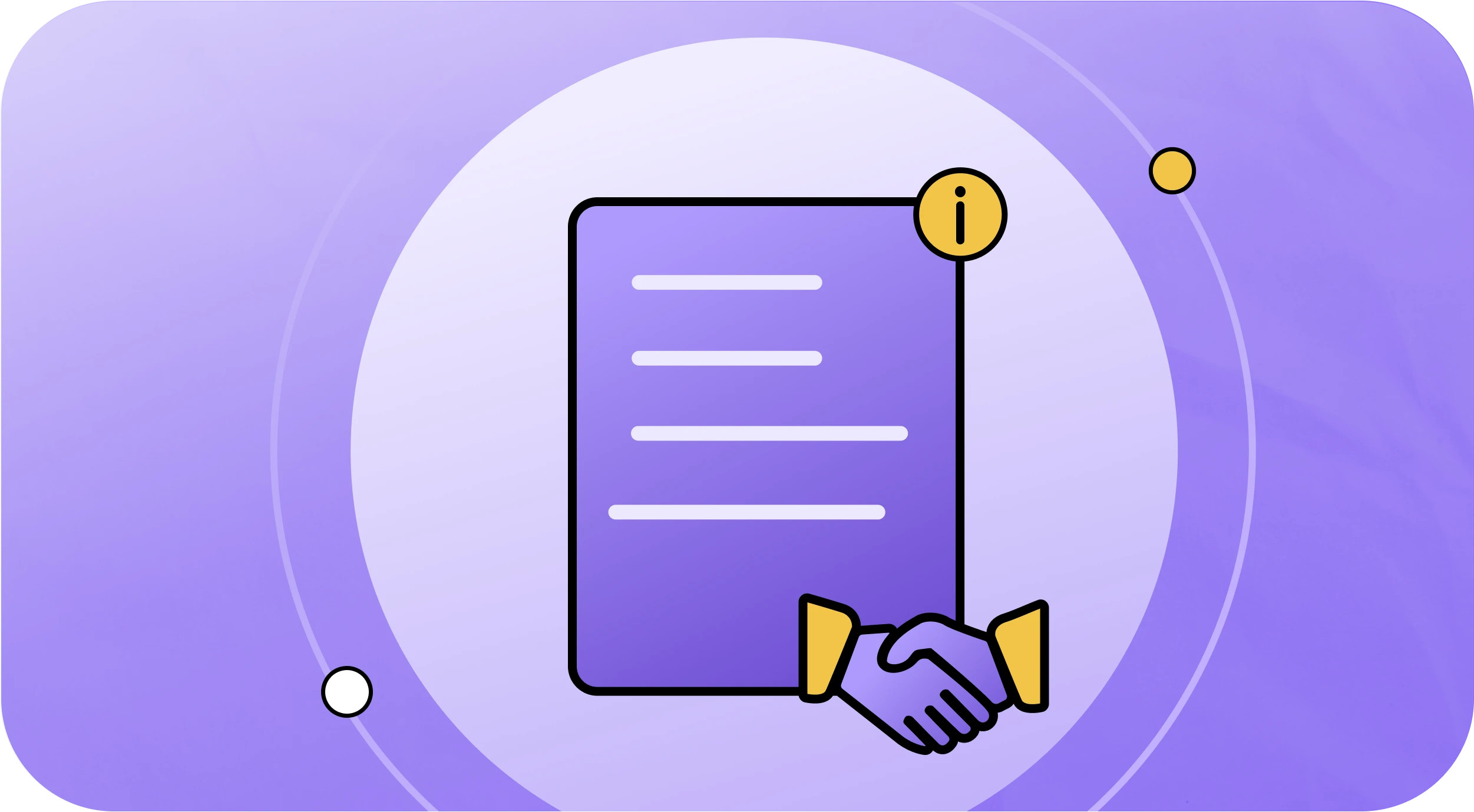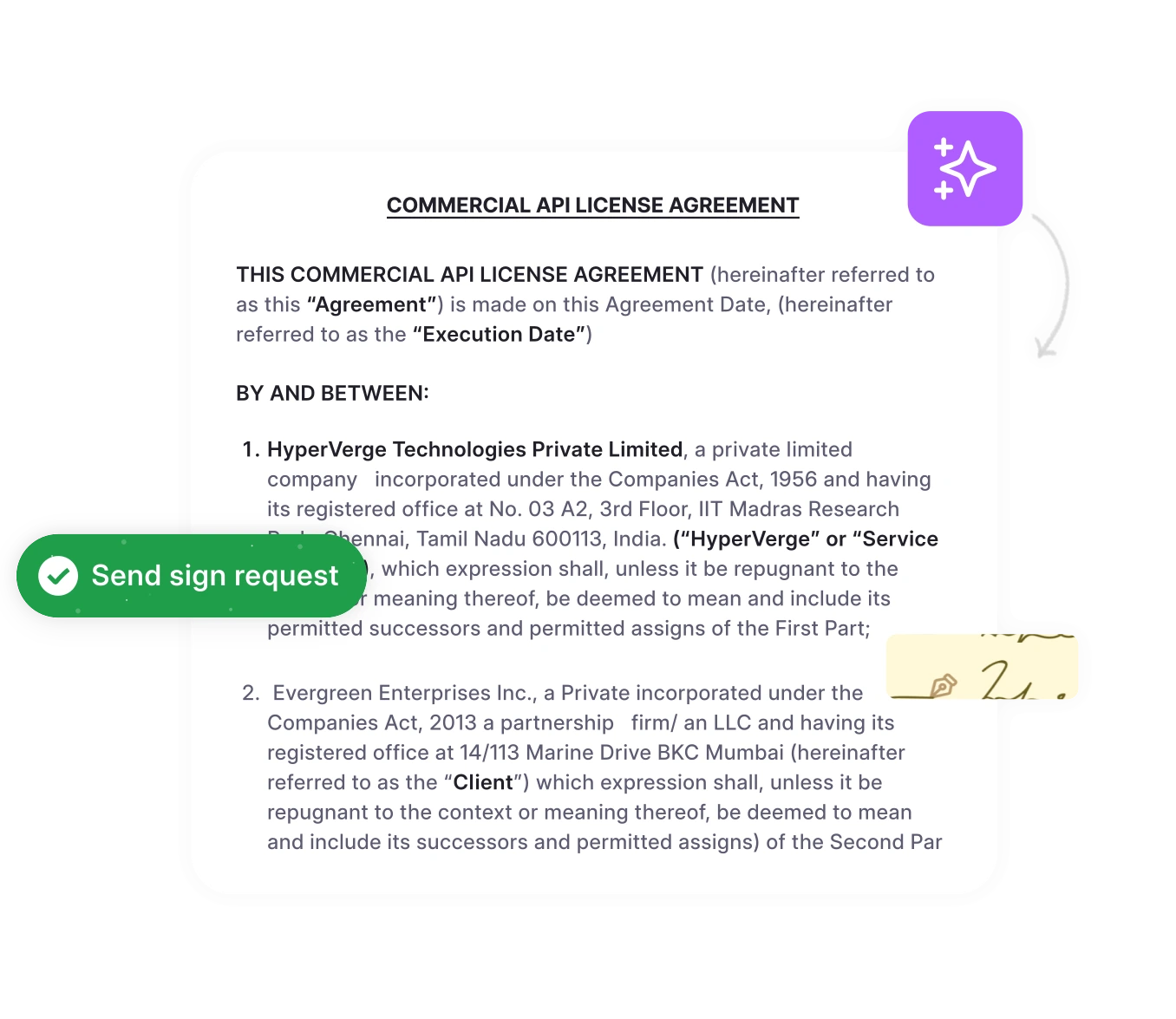Planning to digitalize contract management? You’re not alone. According to WorldCC, 76% of organizations plan to transform contract management to improve efficiency and control digitally. Contract management software is essential for businesses to streamline operations, reduce risks, and improve efficiency.
In this blog, we’ve curated a list of 12 essential contract management software features. Whether you are a startup or an enterprise dealing with 10 or 1000 contracts, these features are universally important for all businesses.
Let’s look at our curated list of 12 features of contract management software without further ado.
12 Important features of contract management software
Here are the 12 contract management features beneficial for your business.
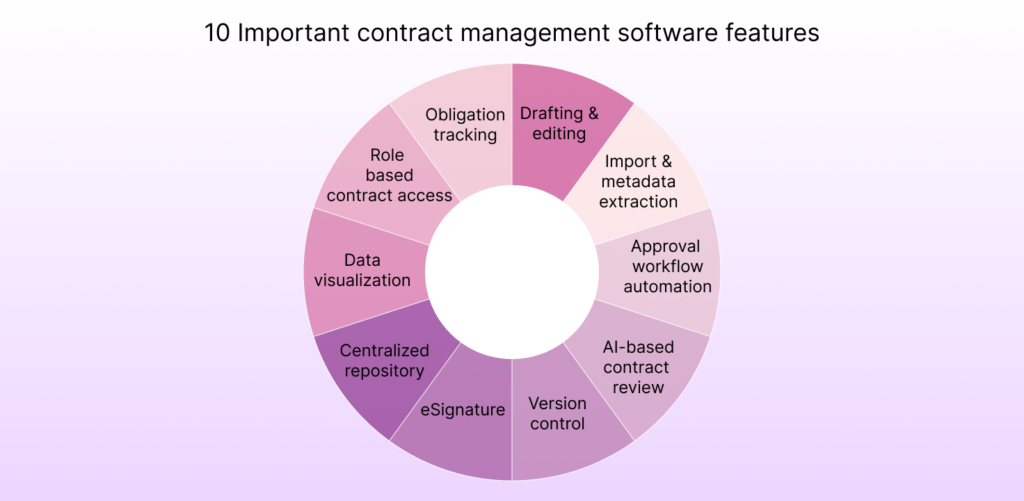
1. Contract drafting and editing
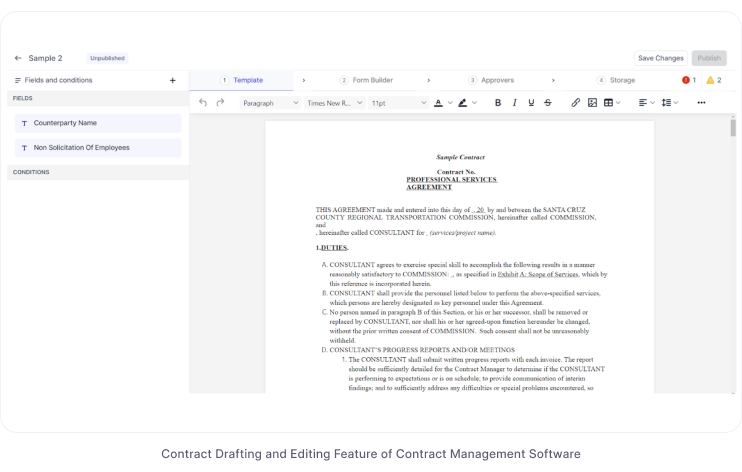
What does the contract drafting and editing feature do?
The contract drafting and editing feature helps users self-serve contracts within minutes through dynamic templates, intake forms, and clause libraries. Non-legal teams use this feature to self-serve contracts, reducing dependency on legal professionals to create agreements. This gives your legal team more space to focus on other important tasks.
Key functionalities of contract drafting and editing
Drag and drop contract creator: Build a new contract by dragging and dropping elements.
Contract templates: Use publicly available formats for contracts and agreements. Build templates through no-code template builders to standardize contract formats.
Pre-saved clause library: Use a library of pre-approved clauses to standardize contract language and speed up drafting.
AI drafting assistant: Leverage generative AI’s assistance with contract creation. Use GPT programs to generate clauses and get feedback on contract terms for errors.
Collaborate: Work with multiple team members and departments to collectively draft a contract.
2. Contract import and metadata extraction

What do the contract import and metadata extraction features entail?
The contract import feature helps transfer all your existing contracts from sources such as Salesforce, Google Drive, Gmail, Zoho Mail, Outlook, and OneDrive to your contract management repository.
Once imported, your entire contract portfolio can be digitally stored in the CLM software. The CLM system then extracts and tags key contract terms like counterparty name, effective date, expiration date, contract value, liabilities, risks, and more for better contract visibility and obligation tracking.
Key functionalities of contract import and metadata extraction
Multi-source import: Import legacy contracts from sources like cloud storage, CRMs, and local drives. Leverage (Optical Character Recognition) OCR technology to scan paper documents and import data.
Metadata extraction: Extract contract-related information (key terms), store, and monitor them in a centralized space.
Automatic tagging: Tag important clauses of imported contracts automatically through artificial intelligence.
Manage Legacy Contracts Easily
Centralize all your legacy contracts with HyperStart CLM’s unique import functionality. Use our 99% accurate AI metadata extraction to extract key terms in seconds.
3. Approval workflow automation

What does approval workflow automation do?
Once the contract is drafted, the review, revision, approval, and signing process begins. The contract approval workflow builder helps automate and accelerate the contract negotiation process and sets guardrails for risk management. Create automated contract workflows for your organization’s contract approval process and accelerate your contract TAT (turnaround time).
Key functionalities of approval workflow automation
No-code workflow builder: Build tailored workflows through a drag-and-drop builder.
Conditional rules: Set conditional logic waterfalls in the workflow and decide how contract approval moves in your organization.
Notifications: Set alerts and email reminders to notify the relevant stakeholders at every approval step.
Pre-built workflow templates: Implement pre-built workflow templates for any contract.
Assign responsibility: Assign contract tasks to different individuals based on their role in the organization.
Redlining: Collaborate with contract stakeholders to redline, negotiate, and revise the contract.
4. AI-based contract review
What does AI-based contract review do?
Once drafted, the contract needs to be reviewed by the internal team and counterparties. The AI review and redlining feature helps accelerate contract reviewing by automatically detecting and flagging faulty clauses. This saves manual contract review time and boosts contract TAT. Automated redlining improves collaboration and reduces time spent on manual counterparty follow-ups.
A 2023 report by the Thomson Reuters Institute states that among the top uses of generative AI in corporate legal operations are contract drafting and review, with 76% of users either currently using or having an interest in using AI tech for these purposes.
Key functionalities of AI-based contract review
Automatic contract review: Deploy AI to review your contract automatically and scan lengthy documents.
Redlining suggestions: Get suggestions to modify highlighted clauses and improve review consistency and efficiency.
5. Version control
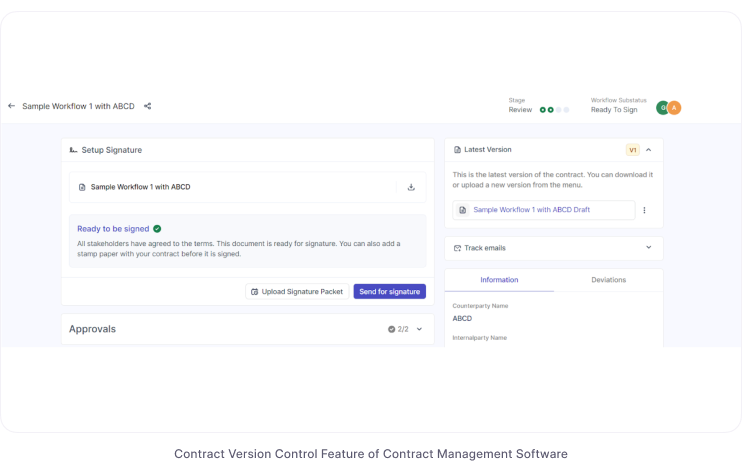
What does version control do?
Keeping track of contract versions helps maintain accountability and trace revisions. The version control feature helps log version changes to maintain contract traceability. You can use version control to trace all redlining changes of a document in one place.
Key functionalities of version control
Audit trails: Get detailed activity logs of all contract versions and see who has viewed, edited, and approved each version of the contract.
Version comparison: Compare two versions of the contract to identify critical changes.
Version locking: Lock the current version of the contract to disable further changes until the version is approved.
Version restore: Restore any previous contract version.
6. eSignature
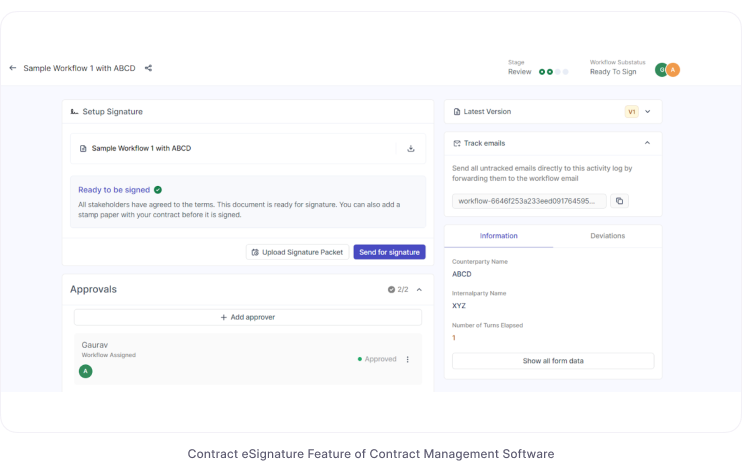
What does eSignature do?
The eSignature feature helps sign contracts effortlessly. Use multiple flexible signing options like hand-drawn signatures, OTP-based signatures, and integrations with e-signature software like DocuSign, Zoho Sign, and Adobe Sign to collect signatures. These options comply with regulations like eIDAS, UETA, and the E-Sign Act.
Key functionalities of electronic signature
Sign documents: Agree contracts through simple and legally binding digital signature methods.
Request signature: Send contract signing requests to counterparties and stakeholders.
Signature reminder: Send automated or manual reminders to counterparties to accelerate the signing process.
Signer authentication: Verify signatures through authentication techniques like OTP.
Get Contracts Signed Fast with HyperStart CLM
HyperStart CLM offers secure, easy eSignature options—hand-draw, OTP-based, or integrate with DocuSign and AdobeSign. Get to a yes faster with HyperStart CLM.
7. Centralized repository

What does a centralized repository do?
A central repository stores all your old and new contracts in one place to avoid juggling between platforms to locate contracts. Having a centralized contract repository helps create a single source of truth where all your contracts are stored in a secure and searchable database.
Key functionalities of a centralized repository
Folder structure: Organize all the related documents in structured folders based on contract types, departments, counterparties, contract value, and other criteria.
Search: Leverage advanced search capabilities to retrieve contracts in seconds with powerful AI filters for key terms, counterparties, and other metadata.
8. Data visualization
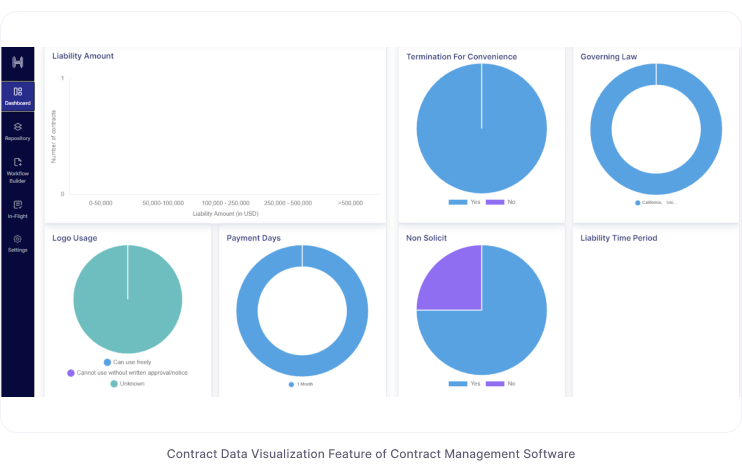
What data visualization does
Contract data is useful for gaining insights into your contracts’ performance and helps with strategic decision-making. The data visualization feature captures all your contract’s information and represents it in a user-friendly way, offering an in-depth analysis to help you with your strategic initiatives.
Key functionalities of data visualization
Data visualization dashboard: Get a visual overview of all your contracts based on pre-defined criteria like expiration date, contract value, liabilities, risks, contract type, etc.
Interactive charts: Access dynamic, clickable charts to see how your contracts perform in real-time.
Risk assessment: Track contract risks based on contract variables like cost, expiration date, and obligations to mitigate risks proactively.
9. Role-based contract access
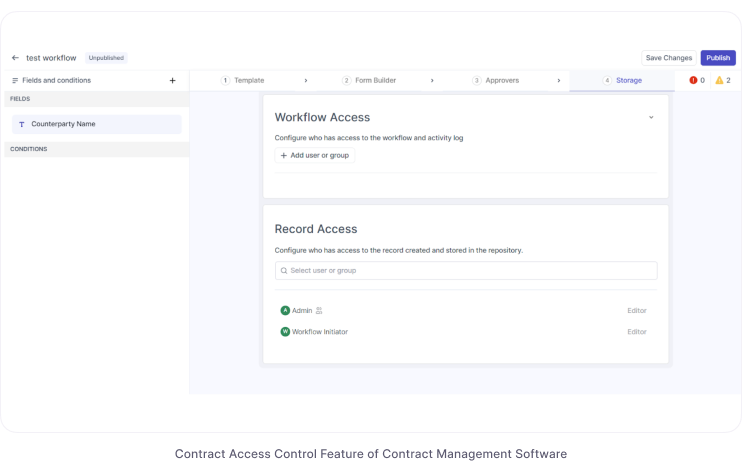
What does role-based contract access do?
The contract access management feature helps maintain the contract’s security. You can set granular access to the contracts and define who works on them at which stage. With access control, your contracts are searchable, trackable, and safe.
Key functionalities of role-based contract access
Add user: Add a new user to your contract workflow and invite new members to collaborate.
Remove user: Remove a user with existing access for complete contract security.
Access level: Add default, conditional, or ad hoc approvers to safeguard contracts at every step.
10. Obligation tracking
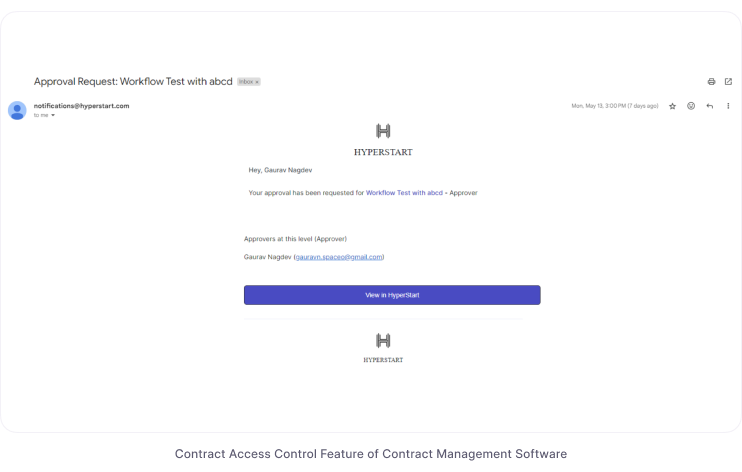
What does obligation tracking do?
Contracts come with numerous legal and business obligations from payments to expiration dates, renewals, and contract terms. Tracking and complying with these obligations, while mandatory, is challenging.
With the contract obligation tracking feature, you can generate automated alerts and email reminders to keep track of all upcoming contract obligations. The obligation tracking feature turns contracts into digital assets to ensure that you never miss a deadline again and comply with contract terms.
Key functionalities of obligation tracking
Set obligations: Manually prioritize obligations and ensure end-to-end compliance.
Automated obligation tracking: Set up email and in-app reminders to track obligations.
Set alerts: Set frequency-based alerts based on contract requirements and legal obligations.
11. AI-Based Contract Management
What does AI-based contract management do?
AI-based contract management streamlines and automates several aspects of contract management, including drafting, metadata extraction, and risk assessment. Leveraging AI can significantly reduce manual errors, save time, and enhance decision-making by providing critical insights into contracts.
Key functionalities of AI-based contract management
Metadata extraction: AI automatically tags important contract clauses, improving contract visibility.
Risk assessment: AI identifies and flags risky clauses, helping you mitigate potential risks.
AI drafting assistant: Generates clauses and detects errors using generative AI models.
12. Security and Compliance
What does security and compliance entail?
The security and compliance feature ensures that all sensitive contract data is well-protected against unauthorized access and complies with international standards like GDPR and SOC 2. This feature is crucial to ensure data privacy, avoid regulatory penalties, and give users confidence in the system’s security measures.
Key functionalities of security and compliance
Data encryption: Encrypts contract data to prevent unauthorized access.
Compliance standards: Ensures compliance with GDPR, SOC 2, and other regulations.
Access control: Set granular permissions to protect data at each level of contract access.
These are the 12 contract lifecycle management software features you should consider while evaluating different contract management systems for your business.
Manage contracts effortlessly with HyperStart CLM
Choosing the correct contract management system is important, whether you are a startup, a growing company, or an enterprise-level business. By picking a scalable contract management solution, you can ensure that your contract management tool’s features grow parallel to the needs of your company.
HyperStart CLM offers end-to-end contract management system features. Our unique AI-focused features help you solve complex contract management challenges, increase CLM efficiency, and reduce contract costs. Book a demo call with our team today to learn more about our contract management tool features.



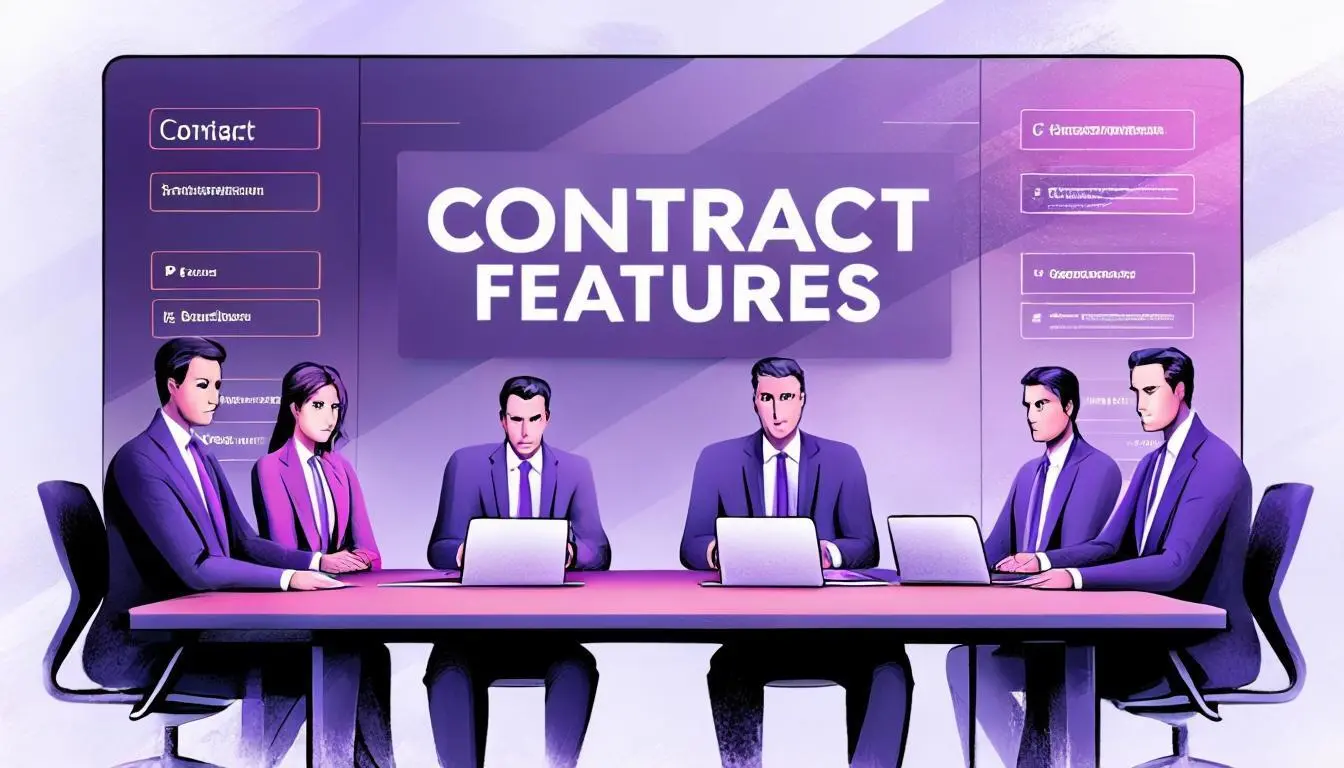




![13 Best Contract Management Software in 2025 [A Guide]](https://www.hyperstart.com/wp-content/uploads/2024/05/1-1-1_3_600x339.webp)

